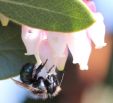Reproductive biology of pointleaf manzanita (Arctostaphylos pungens) and the pollinator-nectar robber spectrum
DOI:
https://doi.org/10.26786/1920-7603(2012)13Abstract
Floral visitor species are often assumed to act either mutualistically towards plants (as pollinators) or to exploit them (as nectar-robbers or as nectar or pollen thieves). We investigated the reproductive biology of pointleaf manzanita (Arctostaphylos pungens K. Kunth), a regionally abundant North American shrub, in relation to the wide spectrum of behaviours displayed by its flower-visiting insects. We recorded A. pungens population-level flowering phenology and nectar standing crop, and conducted experiments documenting its breeding system, in an Arizona upland habitat in 1998 and 1999. Floral visitors were observed over 38 hr. We recorded frequencies of six foraging behaviours within and among individuals of each visitor species.
Arctostaphylos pungens flowers in late winter. During this period it is the only abundant floral resource for a diverse array of generalist insects in its habitat. We observed 1206 floral visits by 46 taxa. Most floral visitors pursued mixed behaviours: at the species and/or individual level, they foraged both legitimately and as nectar-robbers or thieves. The most commonly mixed behaviours were legitimate pollen collection (which likely resulted in pollen transfer) and secondary nectar-robbing (which was highly unlikely to do so). As A. pungens was found to be largely self-incompatible, robbing and thieving visits should be detrimental to reproductive success.
Although theoretical analyses often assume that exploiters must be punished or excluded for mutualism to persist evolutionarily, exploitation is in fact ubiquitous within cooperative interactions in nature. In manzanita, very few floral visitor species could be classified as exclusively beneficial or detrimental to plants: rather, they exhibited multiple foraging strategies, with no evidence of plant control. Such pollinator-nectar robber spectra appear to be common, and constitute an important challenge to current understanding of how mutualism can persist.
NOTE: Supporting information to this article may be found in the left menu.

Published
How to Cite
Issue
Section
License
Copyright (c) 2012 Leif Richardson, Judith L. Bronstein

This work is licensed under a Creative Commons Attribution 4.0 International License.











